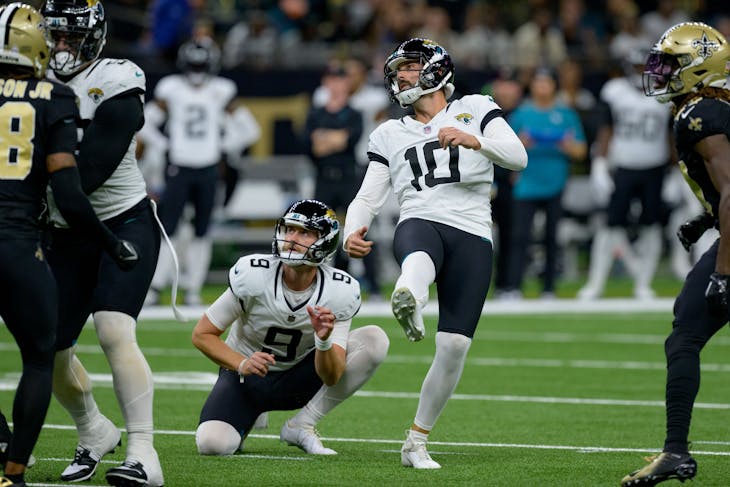
On July 20th, twelve members of the Footballguys staff got together for the site's fourth draft of 2016. Justin Howe provides an in-depth summary of each team and each participant answers questions about their draft and strategies.
League Parameters
- 12 teams
- 20 roster spots
- Starting Lineup
- 1 quarterback
- 2 running backs
- 3 wide receivers
- 1 tight end
- 1 flex (either a running back, wide receiver, or tight end)
- 1 team defense
League Scoring
- Offensive Players
- 4 points - passing touchdown
- 6 points - rushing/receiving touchdown
- 0.05 points - passing yard
- 0.1 points - rushing/receiving yard
- 1 point - reception
- Team Defense
- 6 points - touchdown
- 2 points - turnover recovered
- 2 points - safety
- 1 point - sack
- 10 points - Offensive points against: 0-0
- 7 points - Offensive points against: 1-6
- 4 points - Offensive points against: 7-20
- 1 point - Offensive points against: 21-29
- -3 points - Offensive points against: 30-99
- 6 points each - Number of Defensive and Special Teams Touchdowns
THE DRAFT ORDER
The draft order was created randomly. After the first round, the draft continues in a regular serpentine manner. Click here for the team rosters and the draft pick by pick.
1. BJ Vanderwoude
2. Justin Bonnema
3. Bear Heiser
4. Danny Tuccitto
5. Will Grant
6. Cian Fahey
7. Andy Hicks
8. Ari Ingel
9. Phil Alexander
10. Stephen Holloway
11. Jason Wood
12. James Brimacombe
Starting with BJ Vanderwoude from the 1.01 spot, Justin Howe provides an unbiased evaluation of each team's draft performance
BJ Vanderwoude - Slot 1
| Pick | Ovr | Selection |
| 1.01 | 1 | Brown, Antonio PIT WR |
| 2.12 | 24 | Ingram, Mark NOS RB |
| 3.01 | 25 | Martin, Doug TBB RB |
| 4.12 | 48 | Baldwin, Doug SEA WR |
| 5.01 | 49 | Edelman, Julian NEP WR |
| 6.12 | 72 | Palmer, Carson ARI QB |
| 7.01 | 73 | Hurns, Allen JAC WR |
| 8.12 | 96 | Sims, Charles TBB RB |
| 9.01 | 97 | Jennings, Rashad NYG RB |
| 10.12 | 120 | Graham, Jimmy SEA TE |
| 11.01 | 121 | Miller, Zach CHI TE |
| 12.12 | 144 | Agholor, Nelson PHI WR |
| 13.01 | 145 | Kearse, Jermaine SEA WR |
| 14.12 | 168 | Allen, Javorius BAL RB |
| 15.01 | 169 | Taylor, Tyrod BUF QB |
| 16.12 | 192 | Chiefs, Kansas City KCC Def |
| 17.01 | 193 | Amendola, Danny NEP WR |
| 18.12 | 216 | Eagles, Philadelphia PHI Def |
| 19.01 | 217 | Griffin III, Robert CLE QB |
| 20.12 | 240 | Ware, Spencer KCC RB |
Overall Strategy
Balanced, with a slight wide receiver lean early; punt the tight end (and the backup quarterback)
Best Pick
Charles Sims, 8.12, RB36. Sims was last year’s RB20 in MFL10s during a career resurgence for Doug Martin. I can’t explain the disparity there – that suggests Sims’ star is still on the rise, so RB36 is absurdly low. I expect Sims’ receiving share to keep increasing slightly, and his rushing potential is especially high behind the inconsistent Martin. This is a bald-faced steal.
Worst Pick
Carson Palmer, 6.12, QB7. The sixth round is just far too early for me to dip into the second QB tier, especially for Palmer. I expect a little regression to the mean there; with age and injury history added to the equation, Palmer is one of the riskier options in this tier. The likes of Eli Manning (9th), Andy Dalton (10th), and Matthew Stafford (11th) were available much later. At least Vanderwoude wisely stayed out of the backup QB market until taking two high-upside guys in the 15th and 19th.
Evaluation
This looks like a great value-based draft that went according to plan. Vanderwoude clearly wanted two RB1 types to lean on, and he chose two high-usage guys on the 2/3 turn to do it. But what sets off this WR-heavy roster is the value Vanderwoude pulled at RB in the middle rounds. Guys like Sims and Jennings see more usage than these draft slots suggest, while Allen and Ware look poised to outplay theirs even as NFL backups.
post-draft questions
Drafting first overall can be a challenge, especially at the turn of the third and fourth round. What advice would you give to someone drafting in this slot? In a Best Ball league, is there any difference in strategy? (The first pick has the 2-3 and 4-5 turn)
The merits of drafting Antonio Brown first overall have increased with news that L. Bell will miss the first four games due to suspension. I am also a fan of taking Brown because of the options available at running back in the second and third rounds. In this draft I was lucky enough to snag Doug Martin and Mark Ingram, two running backs who I feel will be every week starters with the upside to finish inside the top five at their position. To take it one step further, I was then able to complete my starting wide receivers by drafting Doug Baldwin and Julian Edelman in the fourth and fifth rounds. The first overall pick is a gift, so I see no reason to overthink the drafting strategy, especially in best ball formats. There is value in the later rounds at quarterback, tight end and running back, so the optimal strategy is to make sure you have high volume starters at wide receiver. The other positions can be put together by committee.
2. Which pick in the first ten rounds of your draft are you most concerned about? Explain your thoughts.
It is a toss up between Allen Hurns (7.01) and Jimmy Graham (10.12). Hurns is my WR4 on paper, but he's also the best candidate to fill my flex position. The Jaguars offense is on the rise due to a wealth of young talent at the skill positions, and I'm worried that the additional mouths to feed--most notably Julius Thomas--will cut into Hurns targets. Additionally, the Jaguars signed Chris Ivory to a rather large contract indicating that they will at least attempt to balance out their offense. This is not good news for a big play wide receiver who needs volume to balance out variance. The upside is certainly there and worth the risk in the seventh round, but his stats are most likely in for a reduction across the board.
Jimmy Graham worries me for many reasons, not least of which is his availability for week 1 (ruptured patellar tendon). Throw in the fact that he is playing in a completely different offense with a different quarterback than his and it's hard not to temper your expectations for a player who has should have as much as any player at his position. I was concerned enough about his prospects that I felt the need to draft Zach Miller immediately following my Graham pick, as I figured a committee approach was the correct strategy given the thin player pool at tight end in the 10th round.
3. What position is most important to have consistent production in Best Ball leagues? How do you draft to ensure this is covered?
I touched on it in my first question, but I think having consistent production out of your top four wide receivers is most important. It is the only position that cannot be cobbled together with a committee approach because of the scoring gap between the top players and those that would be used in that type of strategy. The quarterback position is also very high on my priority list, but that doesn't mean I have to spend a high pick on one. It is important because of the value available in the middle rounds, and the ease of which you are able to put together a competitive group of quarterbacks. If you are not getting 20 points a week out of your starting quarterbacks in best ball formats, you are giving up valuable points to the other players in your league.

